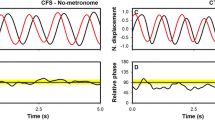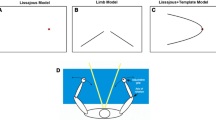Abstract
The performance of many everyday activities requires the coordination of the two upper limbs to achieve the goal of the task. Although bimanual performance has been studied in detail in adults, few studies have examined how children coordinate the movements of the two hands during symmetric and asymmetric bimanual prehension. With the current study, we asked younger (4–6 years, n = 14) and older (7–10 years, n = 16) children to complete a discrete bimanual task. Specifically, they reached to grasp cylinders located at near and far positions in either unimanual or bimanual condition. During bimanual symmetric conditions, participants performed movements with both hands toward two objects located at the same distance (both near or both far), while in the bimanual asymmetric conditions, they reached for objects at different distances. Results of the kinematic analyses indicated that the young children consistently experienced the “two target” effect, whereby bimanual movements were executed more slowly than unimanual movements to the same distance. Older children employed a hybrid strategy, exhibiting slower movements in bimanual congruent conditions, but larger non-dominant apertures in bimanual incongruent conditions. This hybrid strategy was hypothesized to stem from developmental changes occurring in the integration of sensory information around 8 years of age. While older children exhibited temporal and spatial coordination patterns that were similar to patterns reported in adults, large relative timing differences at the start and end of bimanual movements and considerably weaker spatial coupling were seen in the younger children.





Similar content being viewed by others
Notes
Although reach distance and target size were scaled for each participant, the lateral distance from the midline to the start position (i.e., 15 cm to the right and left) was not. Anthropometric data indicate an average chest breadth of 26.8 cm for children aged 4–6 and 30.7 for children aged 7–10. Therefore, for the older children, reach movements were performed in the parasagittal plane extending from the shoulder. In contrast for the younger children, movements were made in a plane that was approximately 1.5 cm lateral to the shoulder plane. Although we do not expect that this biomechanical difference should influence temporal coordination between the limbs, it should be considered when interpreting the results.
Note that there is no hand factor in this analysis because the timing values represent the right hand minus the left hand.
References
Bingham GP, Hughes K, Mon-Williams M (2008) The coordination patterns observed when the hands reach-to-grasp separate objects. Exp Brain Res 184:283–293
Bobbio T, Gabbard C, Caçola P (2009) Interlimb coordination: an important facet of gross-motor ability. Early Child Res Pract 11(2). http://ecrp.uiuc.edu/v11n2/bobbio.html
Brakke K, Fragaszy DM, Simpson K, Hoy E, Cummins-Sebree S (2007) The production of bimanual percussion in 12-to-24-month-old children. Infant Behav Dev 30:2–16
Bruner JS (1970) The growth and structure of skill. In: Connolly KJ (ed) Mechanisms of motor skill development. Academic Press, New York, pp 63–94
Chicoine A-J, Lassonde M, Proteau L (1992) Developmental aspects of sensorimotor integration. Dev Neuropsychol 8:381–394
Chieffi S, Gentilucci M (1993) Coordination between the transport and the grasp components during prehension movements. Exp Brain Res 94:471–477
Churchill A, Hopkins B, Rönnqvist L, Vogt S (2000) Vision of the hand and environmental context in human prehension. Exp Brain Res 134(1):81–89. ISSN 0014-4819
Colombo J (2001) The development of visual attention in infancy. Annu Rev Psychol 52:337–367
Cordo P, Carlton L, Bevan L, Carlton M, Kerr GK (1994) Proprioceptive coordination of movement sequences: role of velocity and position information. J Neurophysiol 71:1848–1861
Diamond A (2006) The early development of executive functions. In: Byalistok E, Craik FIM (eds) Lifespan cognition. Oxford University Press, New York, pp 70–95
Diedrichsen J, Nambisan R, Kennerley S, Ivry RB (2004) Independent on-line control of the two hands during bimanual reaching. Eur J Neurosci 19:1643–1652
Dohle C, Ostermann G, Hefter H, Freund H-J (2000) Different coupling for the reach and grasp components in bimanual prehension movements. NeuroReport 11:3787–3791
Fagard J, Peze A (1997) Age changes in interlimb coupling and the development of bimanual coordination. J Mot Behav 29:199–208
Fagard J, Hardy I, Kervella C, Marks A (2001) Changes in interhemispheric transfer and the development of bimanual coordination. J Exp Child Psychol 80:1–22
Fetters L, Todd J (1987) Quantitative assessment of infant reaching movements. J Mot Behav 19:147–166
Fitzpatrick P, Schmidt RC, Lockman JJ (1996) Dynamical patterns in the development of clapping. Child Dev 67:2691–2708
Goble DJ, Lewis CA, Hurvitz EA, Brown SH (2005) Development of upper limb proprioceptive accuracy in children and adolescents. Hum Mov Sci 24:155–170
Jackson GM, Jackson SR, Kritikos A (1999) Attention for action: coordination of bimanual reach-to-grasp movements. Br J Psychol 90:247–270
Jakobson LS, Goodale MA (1991) Factors affecting higher-order movement planning: a kinematic analysis of human prehension. Exp Brain Res 86:199–208
Jeannerod M (1981) Intersegmental coordination during reaching at natural visual objects. In: Long J, Baddeley A (eds) Attention and performance IX. Lawrence Erlbaum Associates, Hillsdale, pp 153–169
Jeannerod M (1984) The timing of natural prehension movements. J Mot Behav 16:235–254
Kelso JAS, Southard DL, Goodman D (1979) On the coordination of two-handed movements. J Exp Psychol Hum 5:229–238
Kuhtz-Buschbeck JP, Stolze H, Johnk K, Boczek-funcke A, Illert M (1998) Development of prehension movements in children: a kinematic study. Exp Brain Res 122:424–432
Lantero DA, Ringenbach SDR (2009) Factors influencing children’s performances of a steady-state bimanual coordination. Res Q Exerc Sport 80:205–212
Marteniuk RG, MacKenzie CL, Baba DM (1984) Bimanual movement control: information processing and interaction effects. Q J Exp Psychol A 36:335–365
Mason AH (2007) Performance of unimanual and bimanual multi-phased prehensile movements. J Mot Behav 39(4):291–305
Mason AH, Bruyn JL (2009) Manual asymmetries in bimanual prehension tasks: manipulation of object size and object distance. Hum Mov Sci 28:48–73
Mason AH, Bruyn JL, Lazarus J-AC (2010) Bimanual coordination in children: manipulation of object size. Exp Brain Res 201:797–807
Mori S, Iteya M, Gabbard C (2007) Hand preference consistency and simple rhythmic bimanual coordination in preschool children. Percept Mot Skill 104:792–798
Njiokiktjien C, De Sonneville L, Hessels M, Kurgansky A, Vildavsky V, Vranken M (1997) Unimanual and bimanual simultaneous finger tapping in schoolchildren: developmental aspects and hand preference-related asymmetries. Laterality 2:117–135
Pellegrini AM, Andrade EC, Teixeira LA (2004) Attending to the non-preferred hand improves bimanual coordination in children. Hum Mov Sci 23:447–460
Pryde KM, Roy EA, Campbell K (1998) Prehension in children and adults: the effects of object size. Hum Mov Sci 17:743–752
Riek S, Tresilian JR, Mon-Williams M, Coppard VL, Carson RG (2003) Bimanual aiming and overt attention: one law for two hands. Exp Brain Res 153:59–75
Robertson S, Bacher LF, Huntington NL (2001) The integration of body movement and attention in young infants. Psychol Sci 12:523–526
Sherwood DE (2007) Separate movement planning and spatial assimilation effects in sequential bimanual aiming movements. Percept Mot Skills 105:501–513
Sigmundsson H, Whiting HTA, Loftesnes JM (2000) Development of proprioceptive sensitivity. Exp Brain Res 135:348–352
Srinivasan DL, Martin BJ (2010) Eye–hand coordination of symmetric bimanual reaching tasks: temporal aspects. Exp Brain Res 203:391–405
Srinivasan DL, Martin BJ (2012) Does the central nervous system learn to plan bimanual movements based on its expectation of availability of visual feedback? Hum Mov Sci 31:1409–1424
van Beers RJ, Sittig AC, van der Gon JJD (1998) The precision of proprioceptive position sense. Exp Brain Res 122:367–377
von Hofsten C, Rosblad B (1988) The integration of sensory information in the development of precise manual pointing. Neuropsychologia 26:805–821
Wing AM, Turton A, Fraser C (1986) Grasp size and accuracy of approach in reaching. J Mot Behav 18:245–260
Wolff PH, Kotwica K, Obregon M (1998) The development of interlimb coordination during bimanual finger tapping. Int J Neurosci 93:7–27
Acknowledgments
We would like to thank Andrew Minkley for his help with data analysis.
Author information
Authors and Affiliations
Corresponding author
Rights and permissions
About this article
Cite this article
Mason, A.H., Bruyn, J.L. & Lazarus, JA.C. Bimanual coordination in children: manipulation of object distance. Exp Brain Res 231, 153–164 (2013). https://doi.org/10.1007/s00221-013-3678-y
Received:
Accepted:
Published:
Issue Date:
DOI: https://doi.org/10.1007/s00221-013-3678-y




